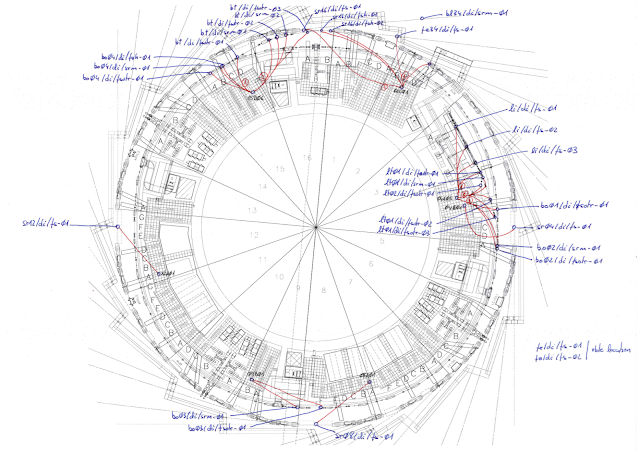From the 54 cameras that we have in side the tunnel, there is one location that is registering more failures than the other positions. Years a go, to find the cameras on their places (and the power source for all of them) I did by hand a map:
You have to have on mind that, following the current information in our cabling data base, we have 18767 cables (with a total length of 168km, on average 11.33m), with 6683 equipments of 728 different types, located in 374 racks.
But back to the reason of this post, there is one ccd camera location, where the hardware dies too often. The technical service from the manufacturer, Basler, have answered to us, something like "what the hell did you did to those cameras!?". They didn't saw this level of damages before.
It is on the top of the map image, but a detail will de useful:
The circles indicates locations of cameras. In red the "sr16/di/fs-01" that to often dies, in blue other cameras. The one near is the "bt/di/fsotr-03" who is not failing (at least not by now). A picture of the place is:
On this picture, the camera is the black box (with white letters saying Scout) on top with a grey network cable on the top.
It's a very important camera, due to the long list of uses it has, specially because when an injected beam to the storage ring is seen here means that one turn is completed (no obstacles in the path).
But why it dies? We know that we are placing this equipments in the tunnel and they can suffer mal functions due to the radiation, but why this is the only place where this cameras die? It looks that we found the reason.
The first hypothesis was: synchrotron light from the transferline. This camera is almost aligned with the second bending magnet from the booster transferline. But is not convincing us.
Basically this camera is 40cm up to the beam pipe. Like, in radians from the aperture, the blue circle at the exit of this bending, where a synchrotron radiation is placed and is not failing.
A secondary hypothesis is neutron scattering. But this is neither easy because the last camera of the booster transferline is also there. Its blue dot is near. The only difference is that the one in the transferline is down the beam pipe and perhaps those particles could have more obstacles in the middle. Maybe yes, maybe not.
Lest look on the storage injection in more detail. Remember the drawing with the coloured circles, there where two boxes besides the red dot, after a bigger box and followed by two more boxes from the first size. The four with the same size are kicker magnets, and the bigger one represents the septum magnet.
Those are pulsed magnets that when there is no injection they don't act, but when there is a beam injection the kickers divert the beam trajectory in four squares and the septum is placing the incoming (blue) and the stored (red) beams very very close:
A very schematic view of what is happening in the septum can be (yes, it can be draw by a kid):
The green line in between both beams is a metallic shielding to isolate the magnetic field of the septum for the booster incoming beam (blue), that the stored beam (red) should not see this field.
The current hypothesis now is that we maybe heating this shielding, scattering back "something" (probably neutrons) and they find the camera in the path. The last camera of the booster transferline is not in the same plane than this shielding.





No comments:
Post a Comment